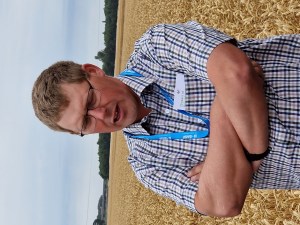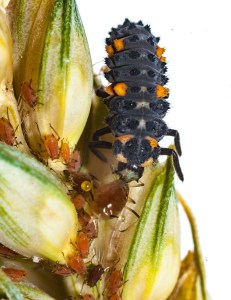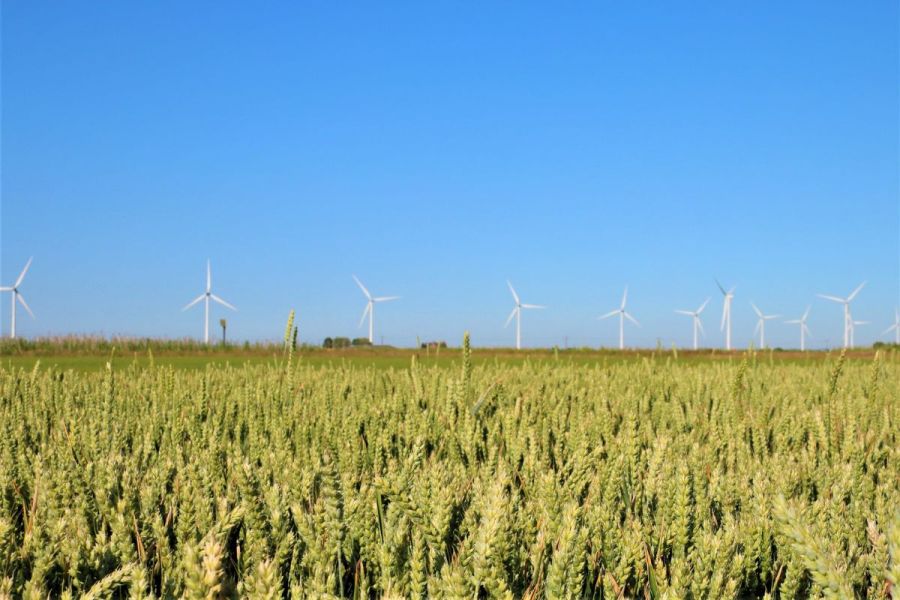On highly fertile soils, a Yorkshire farmer is firmly committed to producing high yields ahead of chasing stewardship funds. CPM finds out how he’s achieving a balance between pushing productivity and environmental considerations.
“The payment rates haven’t been matched to what that land can produce economically.”
By Mike Abram

Wheat yields on the farm, given decent conditions, are slowly increasing, says Richard Hinchliffe, probably due to better genetics and helped by good fungicides.
It’s perhaps a little surprising to learn that Richard Hinchliffe and his family have never entered a government supported environmental stewardship scheme.
The Hinchliffe name is intrinsically linked to Rawcliffe Bridge, near Goole in East Yorkshire. The family farm has worked in partnership with BASF since 2002 to implement practical wildlife enhancing measures to encourage biodiversity, while not detracting from the highly productive arable areas.
The focus in the project has been on using simple techniques, farm labour and standard farm equipment to establish year-round food supplies for birds, as well as roosting and nesting sites, and a managed approach to creating habitats suitable for pollinators.
But the ‘warp’ soils, resulting from the intentional flooding of the adjacent Dutch River in the 1800s, are also highly productive for winter wheat and other combinable crops on the 560ha farm.
That means taking land out of production to put into a Countryside Stewardship scheme isn’t financially attractive, explains Richard.
“We farm in what we would call an environmentally sensitive way but on a highly productive parcel of land – the payment rates haven’t been matched to what the land can produce economically. So we’ve taken action voluntarily, where appropriate, rather than chase government grants.”
The farm is well set up to survive without Basic Payment Scheme funds, he adds. “When it was announced that BPS was going, we took the decision we wanted to be viable without it, and we are as long as we get decent input and output prices.
“If we can’t farm subsidy-free on our better land, then there’s going to be a lot of arable farmers in trouble.”
He suggests with the new Environmental Land Management offers, arable farmers will make a choice between whether to be primarily production-based or whether to chase stewardship funding more significantly.
“There’s plenty of good Grade 1 or 2 land in this country, for example, around the Wash, Humberhead Levels and on the Wolds, where farmers don’t need production-based subsidies because they’ve got the yield.”
But, unlike in previous stewardship schemes, there are some opportunities for him to be paid for actions that he is already taking on the farm within the Sustainable Farming Incentive.
“We’ve had a look at various bits and while the payment rates are not going to be high enough for us to actually change our farming practice, if we can get paid for something that we’re doing already, then that’s a bit different.”

An increased focus on integrated pest management on the farm may mean a change in how decisions are recorded.
For example, he’s considering the Integrated Pest Management and Nutrient Management plans within those two new standards. “We’re already doing those as part of Red Tractor, so might just need to tweak them a little.
“The insecticide-free option is also a possible one for us because we haven’t used insecticides for three years now.”
That decision has partly been driven by the products available for combinable crops reducing in both availability and effectiveness, he admits. “Over time though, I think not using insecticides is benefiting beneficial insects and things are getting more in balance.
“Apart from last harvest, when we had about a dozen or so metre square areas of BYDV in a couple of winter barley headlands, we’ve seen no problems.”
But he wonders whether an increased focus on integrated pest management will mean a change to how decisions are recorded. “I’ve been saying for a few years, half-jokingly, that I’ll end up recording what I haven’t done as much as what I am doing, and that seems to be coming to pass with this new SFI insecticide-free alternative.
“If I want to sign up to that option, then I will be recording that I’ve been crop walking and decided not to use an insecticide.”
Whether current farm management software platforms can cope with recording what hasn’t been done, as well as what has, is debatable, he says. “There’s a good opportunity to make a more farmer-friendly farm management software for growers wanting to do things slightly differently, especially self-advised farmers.
“The market leader is the only one that does it all, but in a clunky, outdated way that makes me want to throw my laptop out of the window. If you could slim it down to the essential parts and make it a bit more modern to use, it would be a really good programme, but there’s probably half of the platform I have never used because it’s not required for a family farm.”
On the farm this February – whisper it quietly – cereal crops are looking perhaps as well they have for over 10 years at this time of year, he says. “If we get good weather, we could have phenomenal yields of both wheat and barley.”
For the past three seasons, the 320ha winter wheat has been drilled from mid-September, with the aim of finishing by the end of the first week of October. That might be a surprise, given Richard’s obsession and zero-tolerance to blackgrass, with the agronomic textbook suggesting better grassweed control from delaying drilling into later October and beyond.
But Richard says while maintaining zero tolerance to blackgrass control is still hard work, it’s no longer the challenge that it was. “I spend six weeks every summer walking through crops making sure there are no grassweeds. We spend more time rogueing every year than we do on any other single job – that’s how important it is.”
As weed numbers reduce, it’s meant the team is able to walk fields more quickly and consequently rogue each one twice or even three times rather than once, he says.
“Now it’s under control, we’re back to early drilling to maximise yields. We lose more yield waiting for this imaginary flush of blackgrass, that doesn’t come now, by delaying drilling. We’re better off getting it drilled and away, growing big roots because that means big yields.”
Budget yields for winter wheat are 10t/ha – the psychological benefit of a nice round number and a smile on the face when the farm beats it, says Richard. But in reality, that’s the lower end of what the farm is capable of.
“Second wheats usually do over 10t/ha. Last year, which was a particularly good year, wheats ranged from 10.5 to over 14t/ha, and averaged just below 12t/ha.”
It’s all Group 4 hard feed wheat with KWS Dawsum – which went “gangbusters” last year – the main variety supported by Costello and Gleam. “Costello is ‘Mr Consistent’ for us – it’s short, stiff, can be drilled early and it’s a bit later to harvest, while Gleam is another high yielder with a flexible drilling date that’s been a good no-till wheat.
“But at the moment Dawsum is the complete package – it did phenomenally well for us last year.”
Early vigour is a key characteristic Richard is looking for in varieties with his no-till system, along with ones that are short and stiff as he doesn’t want too much straw biomass to break down as it’s all chopped.
Along with other tactics, such as mole-draining as often as possible, chopping straw, a diverse rotation and a managed approach to wheelings to make sure they are in the same place every season, 20 years of non-inversion tillage and over 10 years of no-till has helped build more resilience into his clay soils, he believes.
“We’ve noticed our wheats are greener seven to 10 days longer in our long-term no-till system than others near us who more intensively cultivate.”
Wheat yields on the farm, given decent conditions, are slowly increasing, adds Richard, probably due to better genetics and helped by good fungicides.
Last season he used Univoq (prothioconazole+ fenpicoxamid) to open up the possibility of using SDHI fungicide at T3.
“With Uniovq being an alternative mode of action, it allowed me to use Aviator (prothioconazole+ bixafen) at T3, to see whether I could push yield further.”
Despite the tactic working well, it’s not one he’s likely to repeat this season as despite no issues on his farm with his sprayer, he’s not particularly happy with the statements Univoq manufacturer Corteva has issued and the support – or lack of it in his view – that the company is giving to growers.
“I won’t be using Univoq this year, even if they gave it to me. But hopefully it can be reformulated to be a bit more user-friendly as it did a good job.”
In his Real Results tramline-style trial, Richard trialled three programmes – the field comparison was Ascra (bixafen+ fluopyram+ prothioconazole) at T1 followed by Univoq at T2. Innovation programme 2 was similar, with the only difference being Revystar (mefentrifluconazole+ fluxapyroxad) was used instead of Ascra at T1. For the remaining treatment (innovation programme 1), the order of the sprays was swopped – with Univoq at T1 and Revystar at T2.
It was that last treatment which was the one that stood out – with Revystar used at the T2 timing – in the trial, which yields were measured using weighbridge data rather than combine yield maps. This treatment produced a 0.77t/ha increase over the field comparison, and 0.84t/ha more than where the two new fungicides were used in the sequence Revystar followed by Univoq.
While the usual ADAS Agronomics was not able to be used because of the lack of yield maps, the ADAS team suggests the yield benefit for the Univoq/Revystar treatment was large enough to have been likely due to the treatment effect rather than underlying variation.
Disease assessments didn’t hold too many answers for why there was a yield difference, with both Innovation programmes having statistically significantly lower septoria infections on leaf two when assessed in early July than the field comparison, but no other differences were found.
With Univoq not likely to be considered by Richard as an option this season, there’s a strong likelihood that he will be using Revystar at T2, although no firm decision will be made until nearer the time, he says.
“It doesn’t feel right to be making those decisions in February or March, but I do know the main spend will be at T2 – we always go big at T2 using good rates of a good fungicide – while we will decide more season to season on T1 sprays, depending on disease risk at the time,” he concludes.
New BASF option impresses
Spring barley has become a key part of Richard’s rotation since 2016, after a 15-year break from growing it. “We started originally for blackgrass reasons, but now it’s more to maintain a balanced rotation.”
Winter beans have replaced spring beans because they work better in the no-till system, leaving the rotation a little short on spring cropping, he explains. “So spring barley is filling that spring crop area, along with linseed.”
He previously used to struggle to achieve malting specification with spring barley on his predominantly heavy soils, but since its return he has found it possible to consistently make the spec with Planet.
“I think the plant breeding has progressed – we’re managing to meet the below 1.9% N spec using 120kgN/ha, on average.”
That consistency has meant changing from growing predominantly for seed to growing for the brewing market. Yields average 7-7.5t/ha, he says.
This season he will be growing 45ha – typically it varies between 40 and 60ha. It’s all direct drilled, which some growers have struggled to make work with spring barley, he says.
“We’ve just found a way that works for us. Timing of drilling is critical – getting it in on those couple of days that are probably perfect.”
He uses “massive” seed rates of over 500 seeds/m2, which help with lower establishment. “We did a trial last season with up to 720 seeds/m2, and I think we will probably be around 600 seeds/m2 on heavier soil now,” he says.
He applies 75% of the nitrogen in the seedbed and hopes for some rain. Cover crops are not part of the system. “We dabbled with them but couldn’t get them to work on our heavier soils and have now dropped them.”
Planet is a ‘dirty-ish’ variety for disease, he says, but barley is much easier to keep clean than wheat. His programme has been based on Siltra (bixafen+ prothioconazole) but last year was the first time he hasn’t used an all-Siltra programme, with Ascra coming in as the T2 spray.
His Real Results trial for BASF compared Siltra with Tevos (fluxapyroxad+ pyraclostrobin) plus prothioconazole T1, with Ascra plus folpet sprayed across the trial area at T2.
Differences in NDVI (normalised difference vegetation index), captured by satellite imagery before T2 was applied, suggested the BASF treatment resulted in a larger or greener canopy at that time. The difference was less obvious in a later image captured in early July, but it did translate to nearly 0.5t/ha yield improvement in favour of the BASF programme.
That’s encouraging Richard to switch his T1 treatment in spring barley to Tevos plus Innox (prothioconazole) as his farm standard treatment, although he will trial it again against Siltra to make sure it wasn’t a one-off result.
He’s likely to remain with Ascra rather than using Revystar at T2, but it’s not a definite in Richard’s mind yet. “It depends on how it establishes and looks because it’s quite a step up [in price] from Ascra. I was really impressed with how Ascra did – it was the first time I’d used it in barley.”
The Real Results Circle

BASF’s Real Results Circle farmer-led trials are now in their sixth year. The initiative is focused on working with more than 50 farmers to conduct field-scale trials on their own farms using their own kit and management systems. The trials are all assessed using ADAS’ Agronomics tool which delivers statistical confidence to tramline, or field-wide treatment comparisons – an important part of Real Results.
In a continuation of this series we follow the journey, thinking and results from farmers involved in the programme. The features also look at some other related topics, such as environmental stewardship and return on investment.
We want farmers to share their knowledge and conduct on-farm trials. By coming together to face challenges as one, we can find out what really works and shape the future of UK agriculture.
To keep in touch with the progress of these growers and the trials, go here.
This article was taken from the latest issue of CPM. For more articles like this, subscribe here.
Sign up for Crop Production Magazine’s FREE e-newsletter here.




